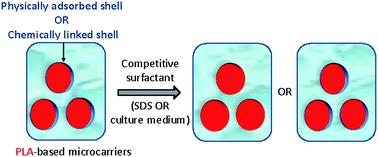Stability of a biodegradable microcarrier surface: physically adsorbed versus chemically linked shells†
Abstract
Mesenchymal stem cells (MSCs) have gained increasing interest for tissue engineering and cellular therapy. MSC expansion on microcarriers (MCs) in stirred bioreactors has emerged as an attractive method for their scaled up production. Some MCs have been developed based on polyesters as a hydrophobic biodegradable core. However, most of these MCs are formulated by an emulsion/organic solvent evaporation (E/E) process using poly(vinyl alcohol) as a shell steric stabilizer, which is biocompatible but not degradable in vivo. Moreover, in most of these MCs, the polymer shell is only physically adsorbed at the particle surface. To the best of our knowledge, no study deals with the stability of such a shell when the MCs are in contact with competitive surfactants or with proteins contained in the culture medium. In this study, fully in vivo bioresorbable dextran-covered polylactide-based MCs were formulated using an E/E process, which allowed to control their surface chemistry. Different dextran derivatives with alkyne or ammonium groups were firstly synthesised. Then, on the one hand, some MCs (non-clicked MCs) were formulated with a physically adsorbed polysaccharide shell onto the core. On the other hand, the polysaccharide shell was linked to the core via in situ CuAAC click-chemistry carried out during the E/E process (clicked MCs). The stability of such coverage was first studied in the presence of competitive surfactants (sodium dodecyl sulfate-SDS, or proteins contained in the culture medium) using nanoparticles (NPs) exhibiting the same chemical composition (core/shell) as MCs. The results revealed the total desorption of the dextran shell for non-clicked NPs after treatment with SDS or the culture medium, while this shell desorption was greatly decreased for clicked NPs. A qualitative study of this shell stability was finally carried out on MCs formulated using a new fluorescent dextran-based surfactant. The results were in agreement with those observed for NPs, and showed that non-clicked MCs are characterized by poor shell stability in contact with a competitive surfactant, which could be quite an issue during MSC expansion. In contrast, clicked MCs possess better shell stability, which allow a better control of the MC surface chemistry, especially during cell culture.



 Please wait while we load your content...
Please wait while we load your content...